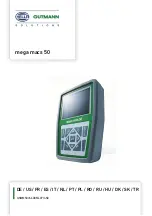
EN-DFA Series
Facebook.com/EmersonAutomationSolutions
LinkedIn.com/company/emerson-automation-solutions
Twitter.com/emr_automation
North America
Only
Emerson Automation Solutions
Americas
McKinney, Texas 75070 USA
T +1 800 558 5853
+1 972 548 3574
Tulsa, OK 74146 USA
T +1 918 662 6161
Europe
Bologna 40013, Italy
T +39 051 419 0611
Asia Pacific
Singapore 128461, Singapore
T +65 6777 8211
Middle East and Africa
Dubai, United Arab Emirates
T +971 4 811 8100
Recommended Spare Parts
The crimp openings in Enardo™ detonation flame
arrestors are relatively large and are therefore quite
easy to clean. Plugging will normally be limited to the
flame cell and screen that are installed at the inlet side
of the arrestor’s element assembly. If plugging should
occur, the plugged flame cell(s) and screen(s) can be
cleaned as detailed above, reinstalled and used again,
provided there is no damage and not plugged to an
extent that cleaning is not effective. For installations
with dirty process conditions where frequent
maintenance is necessary, it is recommended that the
user purchase a spare element assembly and several
spare element gaskets. The spare element assembly
can be installed immediately and the dirty assembly
can then be cleaned and be stored as a spare for the
next maintenance interval.
Note
Element gaskets must be replaced each
time the cell assembly is loosened and
removed. Gasket must be made from
high temperature graphite material. It is
recommended that replacement gaskets
be ordered from Emerson.
Parts Ordering
When corresponding with your local Sales Office
about this equipment, always reference the equipment
serial number and model number stamped on
the nameplate.
3. Assemble the nuts to the studs such that the
amount of thread extending outboard beyond the
nut is approximately equal on both ends.
4.
Tighten the nuts to the torque values shown in
Table 10 following the designated sequence,
repeating he sequence as shown. Flange pattern
tightening sequences are shown in Figure 6.
Bolt Lubrication
Lubrication will affect required torque of clean
fasteners in good condition more than any other factor.
In fact, 90% of applied torque goes to overcome
friction while only 10% actually stretches the bolt.
Table 10 assumes that only factory polymer coating is
used for alloy steel fasteners and machine oil is used
for stainless steel fasteners as a lubricant. Table 9
shows a list of several common lubricants and their
effect on torque required to stretch bolts to 50% of
their yield strength. Most are available from local
bearing distributors.
D103585X012 © 2014, 2021 Emerson Process Management Regulator
Technologies, Inc. All rights reserved. 02/21.
The Emerson logo is a trademark and service mark of Emerson
Electric Co. All other marks are the property of their prospective owners.
Enardo™ is a mark owned by Regulator Technologies Tulsa, LLC, a
business of Emerson Automation Solutions.
The contents of this publication are presented for informational purposes
only, and while every effort has been made to ensure their accuracy,
they are not to be construed as warranties or guarantees, express or
implied, regarding the products or services described herein or their use
or applicability. We reserve the right to modify or improve the designs or
specifications of such products at any time without notice.
Emerson Process Management Regulator Technologies
Tulsa, LLC does not assume responsibility for the selection, use or
maintenance of any product. Responsibility for proper selection, use
and maintenance of any Emerson Process Management Regulator
Technologies Tulsa, LLC product remains solely with the purchaser.






























